The agribusiness sector in Asia is booming, thanks to a growing need for sustainable farming and new farming methods. Countries in this fast-paced region are investing more in agriculture, showing a clear path to economic growth. The Asia agribusiness market is expected to grow strongly, focusing on food security and better quality food.
This article looks at the many sides of agribusiness in Asia, covering trends, major markets, and government policies. We aim to give useful tips for those interested in investing in agriculture and sustainable farming in Asia.
Introduction to Agribusiness in Asia

The agribusiness in Asia is key to the region’s growth. It drives the economy forward. Asia’s varied climates and cultures support a wide range of crops and livestock. This variety helps feed a growing population and boosts the economy.
China and India lead in growing staples like rice, wheat, and soybeans. Southeast Asia is famous for its tropical fruits and spices. These products meet local needs and help with international trade. Agribusiness is crucial for rural areas, offering jobs and encouraging new ideas.
The need for more food is growing fast. So, tackling the challenges and chances in agribusiness is vital. This sector supports food production and promotes sustainable growth. It benefits the economy and protects the environment.
Current Trends in Asian Agribusiness
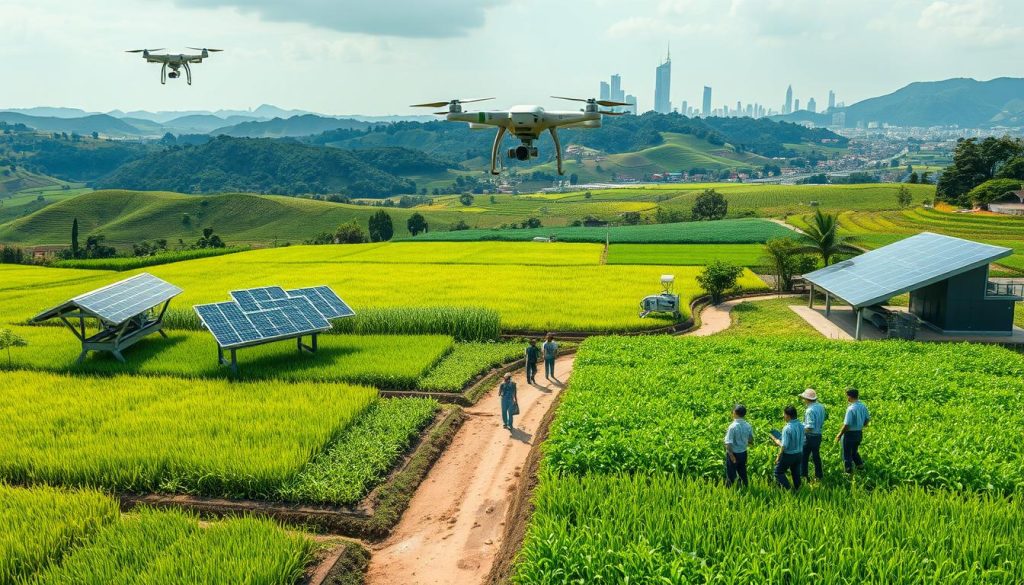
Asian agribusiness is changing fast, thanks to new tech and a push for green farming. These changes are making farming better and changing how we see food.
Technological Advances in Farming
New tech is changing farming for the better. Precision farming lets farmers use resources wisely, boosting crop yields. Data helps farmers make smart choices, making farming more efficient.
Automation is also helping, cutting down on costs and making farming more productive. This lets farmers keep up with what customers want.
Shift Towards Sustainable Practices
More people want to buy eco-friendly products, leading to a focus on green farming. Farmers are now using methods that protect the environment and use fewer chemicals. This not only meets customer needs but also helps farming stay sustainable for the future.
Key Markets for Agribusiness Investment
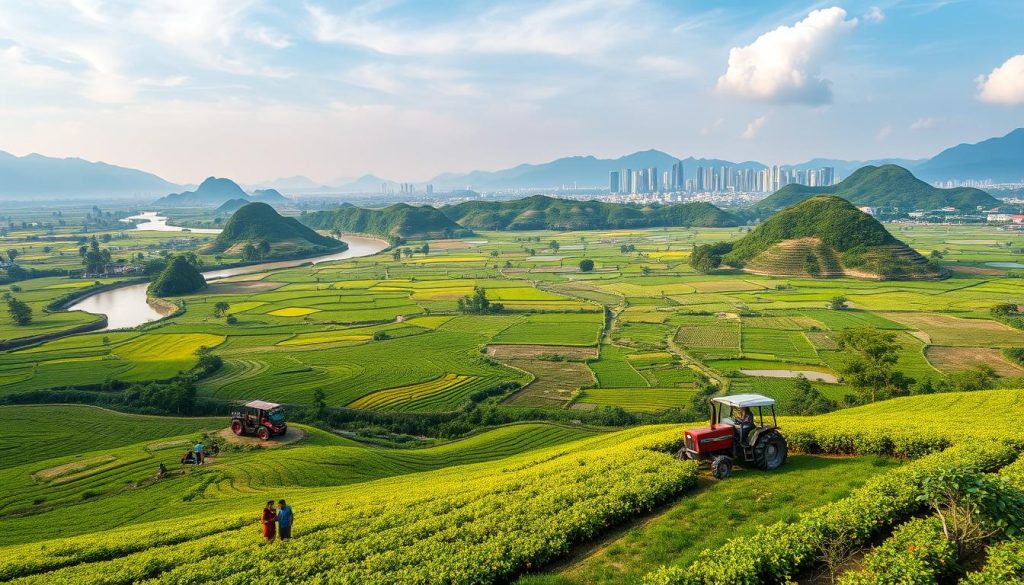
Asia’s agribusiness markets are growing fast and full of new chances. This part talks about the main areas for investment. We focus on China, India, and ASEAN as key spots for putting money into agribusiness.
China’s Growing Agricultural Sector
China’s farming is a big part of its economy. The country is using new tech to make farming better and more efficient. Also, more people want better and greener food, which creates big chances for agribusiness.
Investing in China’s farms can lead to growth. The government is working hard to make farming modern and green.
India’s Evolving Food Processing Industry
India’s food processing is changing fast, offering great chances for investors. More people moving to cities means they want easy-to-eat foods. This is making India a key player in agribusiness.
The government is helping by improving food processing’s tech and infrastructure. This makes the industry even more promising.
ASEAN Countries and Regional Opportunities
The ASEAN agribusiness scene offers many chances across its countries. Working together and trade deals make it easier for agribusiness to grow. Each country has its own strengths, from farming to new food ideas.
Together, ASEAN is working to make food systems better. This helps agribusiness grow even more.
Agribusiness Opportunities in Asia
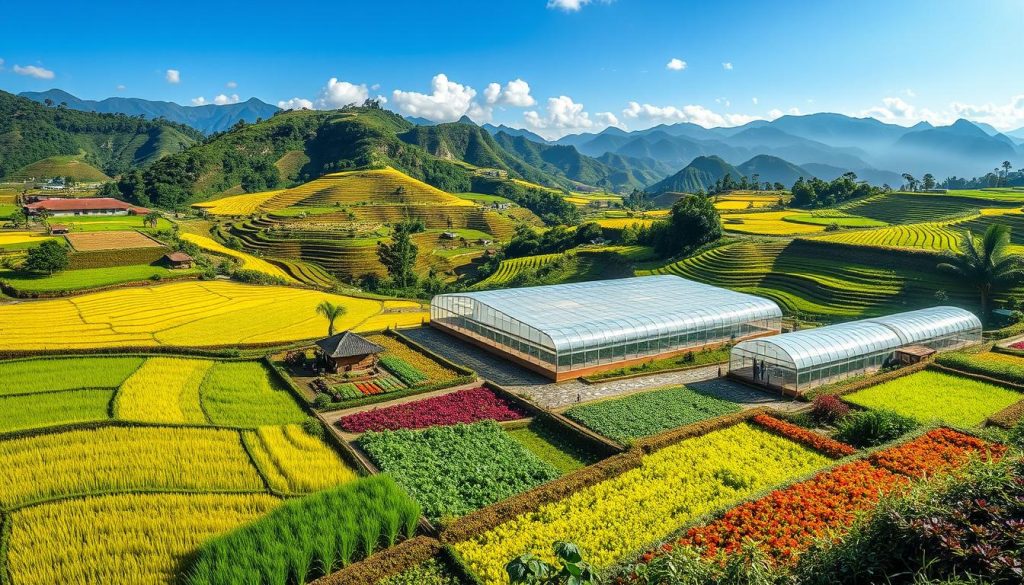
Asian agriculture offers many chances for investors to grow their portfolios. The demand for organic food is rising, showing people want healthier choices. Organic farming meets this need and is a smart, sustainable choice for investors.
Aquaculture is also a key area in Asian agriculture. With more people wanting seafood, investing in modern aquaculture can pay off. This field uses new technology to improve how fish and seafood are raised, making it more sustainable.
Agro-tourism is becoming a big opportunity too. It links farming with tourism, helping rural areas earn more. Working together, big companies and new startups can make this sector more exciting and draw in more visitors.
Government support is crucial for agribusiness growth. Policies that encourage innovation can make farming more efficient and productive. The mix of what consumers want, government help, and new ideas makes Asia a great place for investors.
Government Policies Supporting Agribusiness
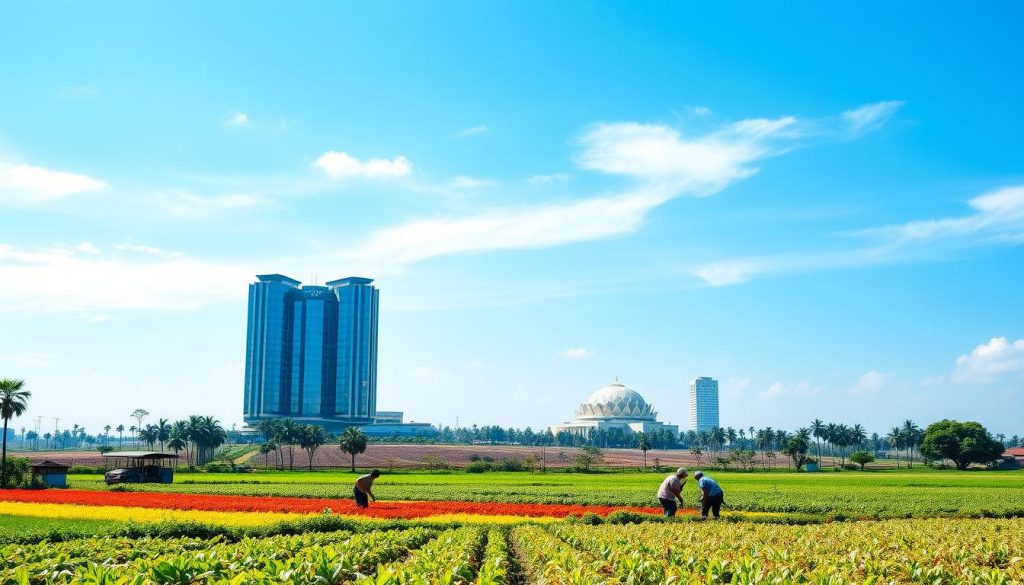
Government policy is key in growing agribusiness in Asia. It aims to boost productivity and make investors more confident. Many initiatives offer support through subsidies, tax breaks, and changes in rules. These help create a better space for those in the farming sector.
Across Asia, countries have their own ways to tackle big issues like food security and helping rural areas. They work on improving roads, making it easier to get loans, and pushing for farming that’s good for the planet. Some big efforts include:
- Subsidies to cut down the cost of things like seeds and fertilisers, helping crops grow better.
- Tax breaks for companies using new farming tech, encouraging them to use modern methods.
- Programmes for small farmers, making sure they’re part of the growth in agribusiness.
Working together, countries can make these policies even more effective. They share resources and learn from each other. This teamwork is key to bringing new ideas and boosting trade in farming across Asia.
Challenges Facing Agribusiness in Asia
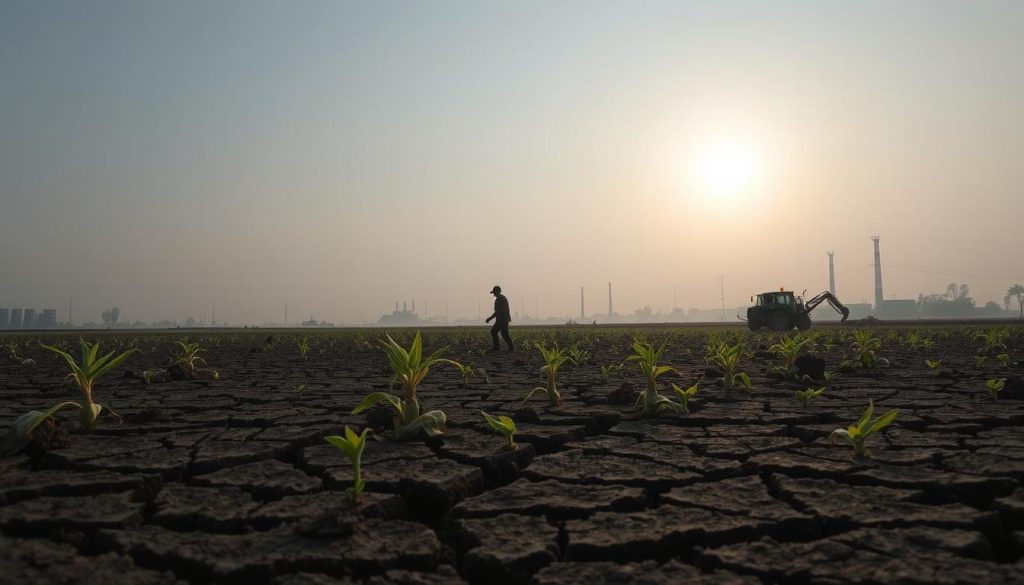
The agribusiness sector in Asia is facing many challenges. These issues affect productivity and sustainability. Climate change and supply chain problems are major concerns that need quick action.
Climate Change and Its Impact on Agriculture
Climate change is a big threat to food security in Asia. Weather patterns are changing, leading to unpredictable rain and extreme temperatures. This hurts crop yields a lot.
Natural disasters like floods and droughts are happening more often. They make farming unstable. Also, rising sea levels are threatening coastal farms, making things even harder.
Supply Chain Disruptions
Global events have shown how weak supply chains are. Trade tensions and the COVID-19 pandemic have caused big problems. They’ve led to delays and higher costs.
Farmers now struggle to get their products to market quickly and keep quality high. To solve these issues, we need new ideas and careful planning. This will help make agribusiness more resilient.
Investing in Smart Agriculture Solutions
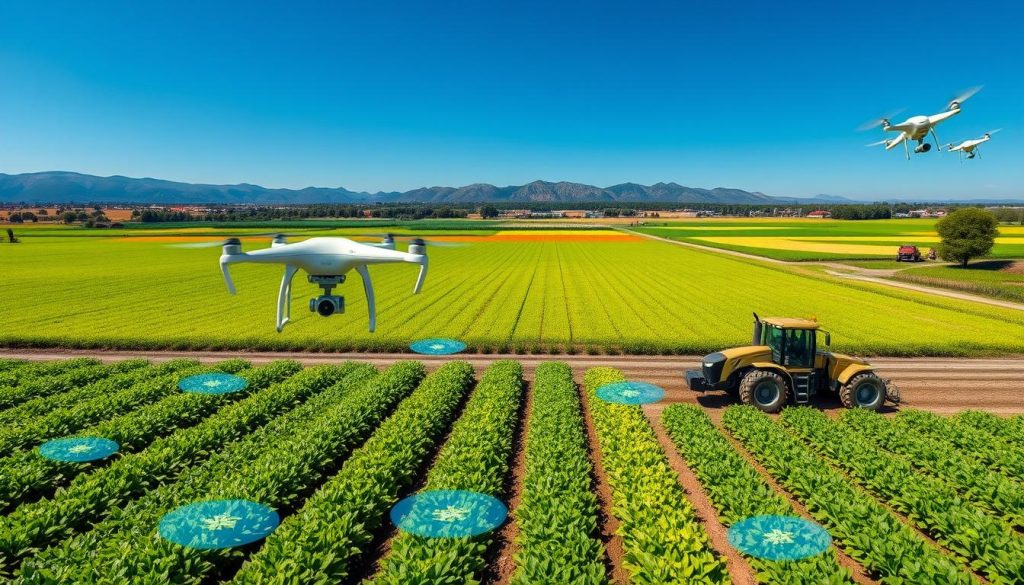
Smart agriculture is changing farming in Asia, making it more productive and sustainable. It uses technology and biotechnology to improve farming. This leads to better crop yields and more efficient farming.
Precision Farming Technologies
Precision farming uses new technologies to help farmers manage better. It includes:
- Drones that take pictures from above to check on crops.
- IoT sensors that send data on soil and weather in real-time.
- Software that helps farmers make smart decisions about planting and harvesting.
These tools help farmers use water, fertilisers, and pesticides more wisely. This reduces waste and protects the environment while helping crops grow well.
Biotechnology and Genetically Modified Crops
Biotechnology is key in solving food security and climate change issues. Genetically modified crops have big benefits:
- They resist pests and diseases better.
- They are more nutritious and last longer.
- They can handle tough weather conditions.
These innovations help farmers grow more food and keep farming productive even when the weather changes. Using these advanced technologies can really boost the Asian agribusiness sector.
The Role of Startups in Agribusiness
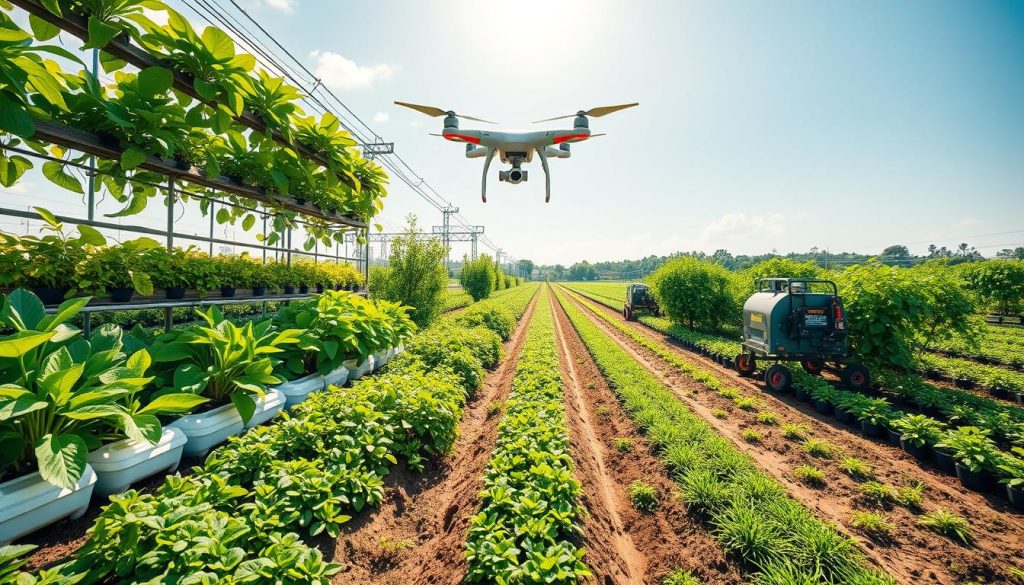
Agribusiness startups are changing the face of farming in Asia. They use new technology to solve big problems for farmers. This includes better managing resources and keeping an eye on crops. These startups are bringing fresh ideas to farming, creating new chances for entrepreneurs.
Agri-tech companies are making farming more productive and green. For example:
- Smart irrigation systems that save water.
- Biological pest control that cuts down on chemicals.
- Blockchain for safer and more traceable food.
Startups like GrabAgric and AgroStar help small farmers get better tools. They make farming better and give new entrepreneurs a chance to join in.
Also, the teams around these startups are key. They work with universities, governments, and investors. This teamwork helps share knowledge and resources, making it easier for everyone to grow.
The growing interest in agribusiness startups shows a big change in farming. These efforts are tackling big problems and promoting green farming. They are becoming essential for the future of farming.
Food Security and Agribusiness Growth
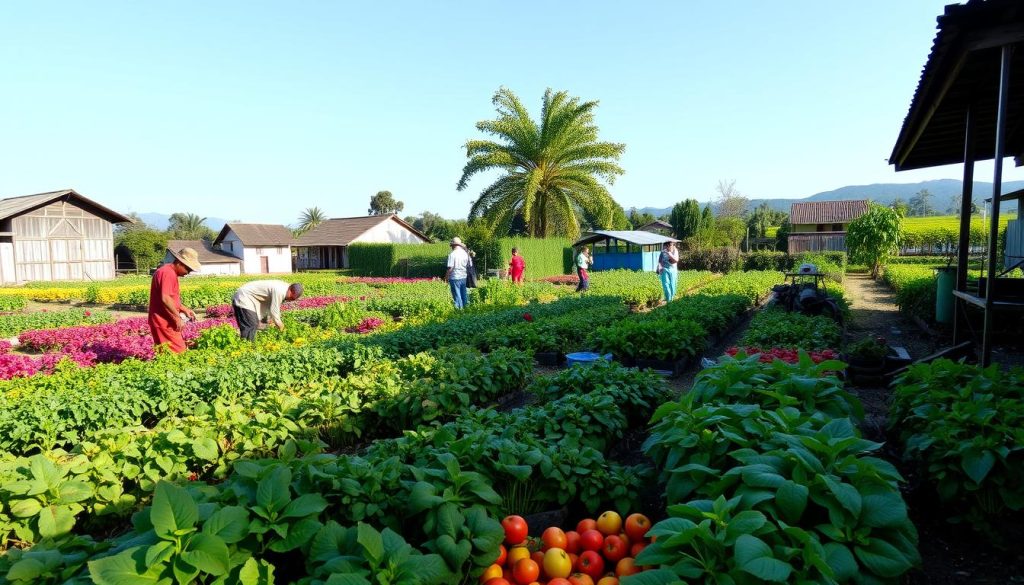
Food security and agribusiness growth go hand in hand for sustainable development. Investing in infrastructure, like food distribution networks, is key. It helps tackle local food system challenges. Good distribution cuts down on food waste and makes fresh produce more accessible.
Investments in Food Distribution Networks
Improving food distribution networks boosts agribusiness. Better logistics and storage mean food gets to consumers faster, reducing waste. The benefits are clear:
- Less food spoils during transport.
- Local farmers make more money.
- Consumers get a wider range of food choices.
Enhancing Local Food Production Systems
Local food systems are crucial for food security and community strength. Investing in local farming helps farmers and offers more food variety. The perks are many:
- It promotes eco-friendly farming.
- It strengthens community bonds through local food.
- It supports community food choices, boosting food sovereignty.
Exporting Agribusiness Products from Asia
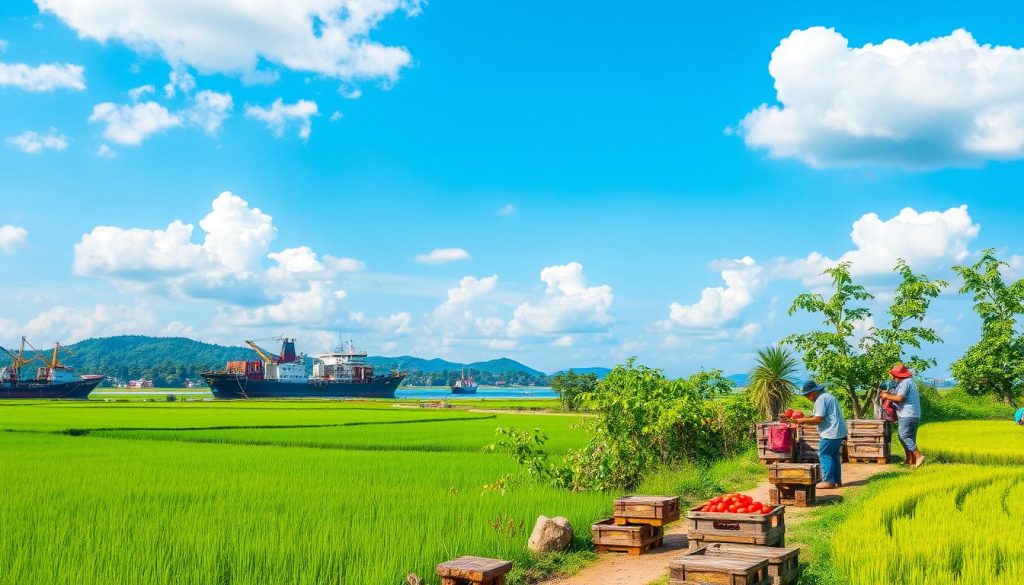
The chance to export agriculture products from Asia has grown a lot. This is because more people around the world want fresh food. Countries in Asia, known for their diverse farming, are well-placed to meet this demand.
However, exporters face the hurdle of complex trade barriers. These barriers can block growth opportunities.
Global Demand for Asian Produce
There’s a big increase in demand for Asian farm products globally. People want better, fresher, and more exotic food. This demand comes from several factors:
- More people are eating healthily, which means they want more fruits and veggies.
- Populations are growing everywhere, making food more necessary.
- There are more chances to export seafood and special products from the region.
Overcoming Trade Barriers
Despite the good outlook for exporting farm products, there are many trade barriers. These can be:
- High tariffs on some farm goods, making them more expensive and less competitive.
- Rules and regulations that need a lot of paperwork and food safety checks.
- Challenges with getting products to market, like delays and poor infrastructure.
To beat these barriers, exporters can try a few things:
- Creating strong global supply chains for better logistics.
- Using free trade deals to lower tariffs and make it easier to get into markets.
- Investing in solutions to make following rules easier.
Case Studies of Successful Agribusiness Ventures
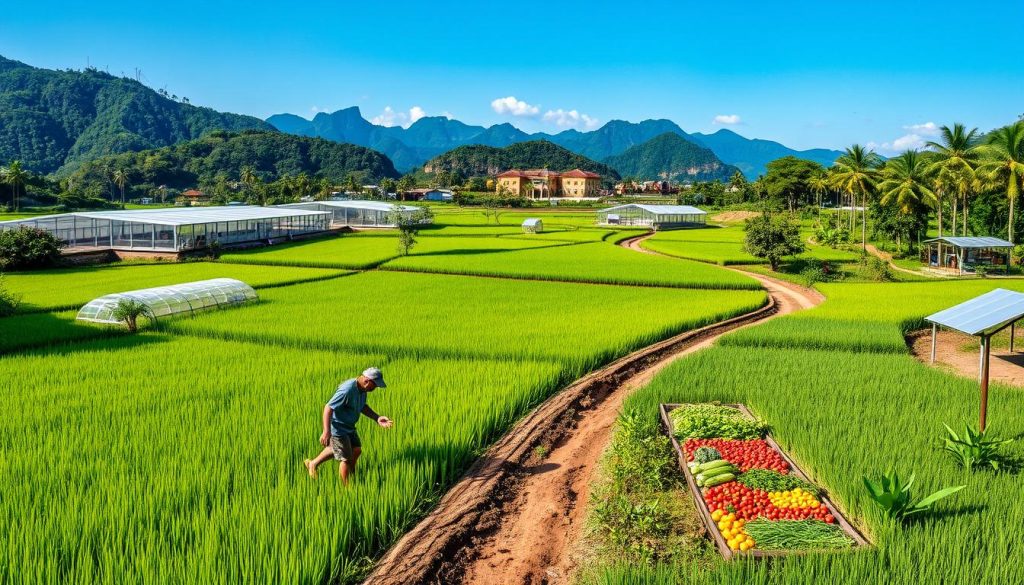
Looking at agribusiness case studies gives us a peek into how companies in Asia work. Many successful ventures show us how to make money and help society at the same time.
Olam International is a great example. It has grown a lot by focusing on sustainable products. The company invests in local communities and sources products responsibly. This approach helps it make money and protect the environment.
Green Monday in Hong Kong is another success story. It promotes plant-based foods through smart marketing and partnerships. This shows how business can benefit both the company and society.
In Indonesia, farmers are trying out different crops. This helps them manage risks and use resources better. It shows the importance of good farming practices.
These stories teach us a lot about making it in agribusiness. They give us tips for investors looking to succeed in Asia. By studying these ventures, we can learn from their strategies.
The Future of Agribusiness in Asia

The agribusiness scene in Asia is changing fast, full of growth and new ideas. People want healthy, organic, and local food more than ever. This shift is key for those looking to make the most of new chances in the market.
Emerging Markets and Opportunities
Asia’s agriculture future looks bright, with trends like urban farming and vertical agriculture leading the way. These approaches boost productivity and support green practices in crowded places. Technology, like automation, is crucial for making farming more efficient and productive.
- Urban farming cuts down on food transport costs and pollution.
- Vertical farming makes the most of city space, meeting the needs of growing cities.
- Automation tackles labour shortages and improves crop quality.
As Asian economies grow, so will the chances in agribusiness. Staying updated with these changes can put you ahead in the competitive market.
Networking and Collaboration in Agribusiness
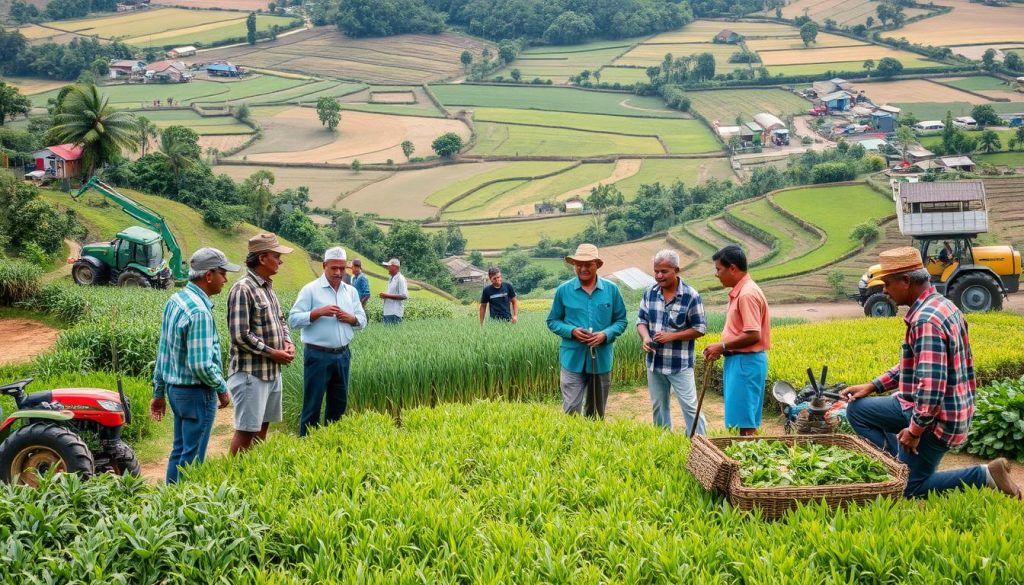
Networking and collaboration are key to success in agribusiness. They help connect stakeholders, share knowledge, and exchange best practices. Industry associations are crucial in creating these chances. They keep professionals updated on the latest trends and developments.
Joining Industry Associations
Joining industry associations opens up a world of resources for agribusiness professionals. These groups offer insights into market trends, regulatory changes, and new technologies. Being part of them can help grow personally and professionally through:
- Access to valuable training and professional development opportunities
- Participation in comprehensive research initiatives and findings
- Connections to potential partners and collaborators
Participating in Agribusiness Conferences
Agribusiness conferences are great for networking and showcasing new ideas. They offer:
- Direct interactions with industry leaders and decision-makers
- Opportunities to present new ideas and concepts.
- Exposure to cutting-edge technologies and practices through expert-led sessions
Attending these conferences can greatly help agribusiness ventures grow. Networking here strengthens professional ties and lays the groundwork for tackling industry challenges together.
Conclusion and Call to Action

The world of agribusiness in Asia is full of chances for growth and new ideas. Investing in technology and green practices is key. As agribusiness changes, we must keep up and work together. Now is the perfect time to get involved, whether by investing or backing new startups.
We must understand the challenges and chances in agribusiness. It’s important to think ahead and act now. Join industry groups, go to conferences, and make partnerships to help farming grow. This will help you grow personally and make the sector better.
- Invest in innovative agribusiness solutions.
- Support local agricultural initiatives.
- Collaborate with industry experts for greater impact.
By getting involved in agribusiness now, we can shape the future of farming in Asia. This will lead to a greener and more sustainable future.
Final Thoughts on Agribusiness Opportunities
The agribusiness scene in Asia is lively and full of chances. It’s important to see how fast this sector is changing. Markets and what people want are always shifting.
Those who get this can grab the opportunities that come up. It’s not just about keeping up; it’s about leading the way with new ideas and green practices.
Investors and business starters can help make sure everyone has enough food. They can also help the economy grow. By focusing on being green, they can make their businesses last for a long time.
In short, Asia’s agribusiness offers many chances for those who are ready. Being quick to adapt and informed is key to doing well. With smart plans, the future of agribusiness in Asia looks very bright.
















